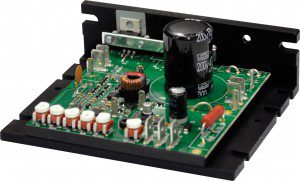 KB Electronics now sells two battery-powered speed controllers … dc/dc low-voltage motor speed controls. The KBBW Series of pulse-width-modulated (PWM) dc/dc motor speed controls respond dynamically to load variations. PWM produces an almost pure dc current to the motor for low noise and long brush life. Pulse-by-pulse current limit provides short circuit protection and prevents control damage due to shorted motors.
KB Electronics now sells two battery-powered speed controllers … dc/dc low-voltage motor speed controls. The KBBW Series of pulse-width-modulated (PWM) dc/dc motor speed controls respond dynamically to load variations. PWM produces an almost pure dc current to the motor for low noise and long brush life. Pulse-by-pulse current limit provides short circuit protection and prevents control damage due to shorted motors.
Model KBBW-12 operates on 12 Vdc and model KBBW-22 operates on 24 VDC.
A plugin horsepower resistor (PHR) (supplied separately) eliminates the need for recalibrating the IR Compensation and Current Limit settings when the control is used on various horsepower motors.
Quick-connect terminals are standard for all connections to the drive. Adjustable trimpots allow the drive to be tailored to specific applications. The Inhibit Circuit can be used to stop and start the drive electronically with a switch or contact. A 5-kΩ potentiometer, 0-to 5-Vdc analog signal or a PWM microprocessor output signal control motor speed.
The optional Auxiliary Heat Sink Kit (Part No. 9142) increases the drive’s current rating from 14 Adc to 20 Adc.
Connect with KB Electronics on Twitter.


Leave a Reply
You must be logged in to post a comment.